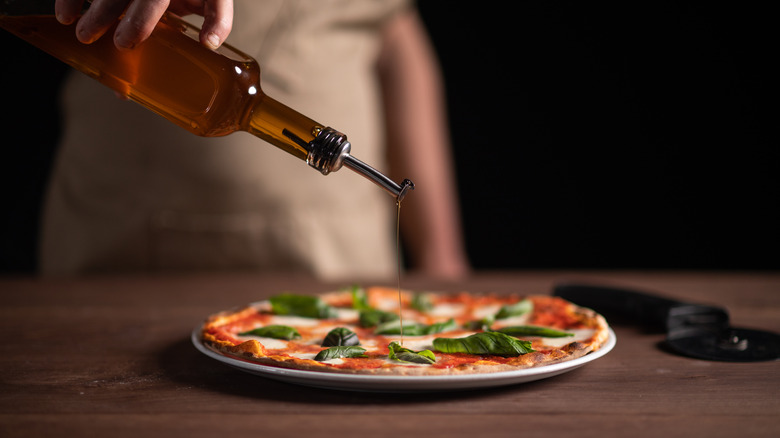What Makes Pizza Oil Different From Olive Oil?
When perusing the oil section of your grocery store, you may have noticed a new addition sandwiched between the garlic-infused or truffle-heavy bottles — pizza oil.
The concept has become more well known in recent years, with olive oil brand Brightland launching their own version in early 2023, which quickly spurred on a cult following. Since then, several major brands, including a collaboration between Williams Sonoma and the Ooni pizza oven company, have launched their own spin on this tasty pizza topper.
But what makes pizza oil any different from olive oil? The short answer is lots of delicious add-ins. While it's common to see olive oils flavored with garlic or herbs, the main difference with pizza oil is that it typically has a powerful combination of pizza-centric herbs like oregano or basil, some source of heat including red pepper flakes or fresh peppers, and a dose of garlic. This trio is the perfect mix to add flavor to a bland pizza, or amp up the already present tastes in your favorite slice from the corner shop.
Buying pre-made pizza oil can be a bit pricey depending on the brand and variety you choose. While it may be worth the investment for some, you can also recreate your own version at home. Start with a high-quality olive oil and lightly saute your favorite add-ins, strain, and you're ready to eat! Just be sure to refrigerate your mixture when you're done, to avoid spoilage.
How to use pizza oil at home
Using pizza oil may seem like a no-brainer, but there are a few tips to keep in mind. If you're indulging in homemade pizza, don't put the oil on before baking. While you may be tempted to slather the crust with a dose of it prior to cooking, any small pieces in the mixture, such as herbs or pepper flakes, have the risk of scorching in the oven. High temperatures can also destroy some of the fruity notes of the olive oil base. Ideally, use the product only as a finishing oil for the best results.
Some brands have already caught on to this trick, but if your pizza oil is sold in a glass bottle (or you've made a DIY version at home), try transferring it to a plastic squeeze bottle. This will give you more control when you're drizzling it atop your next meal, versus the risk of accidentally dumping a large amount on your freshly made pie.
Pizza oil is delicious whether it's homemade, from a restaurant, or even when used to dress up frozen pies. But this delicious topper can be applied to a variety of other dishes beyond its advertised use. It also works well on pasta, eggs, or even served in a bowl with bread for dipping. Your creativity is the only limit, so use it anywhere that needs an extra zing of spice and flavor with minimal effort.


